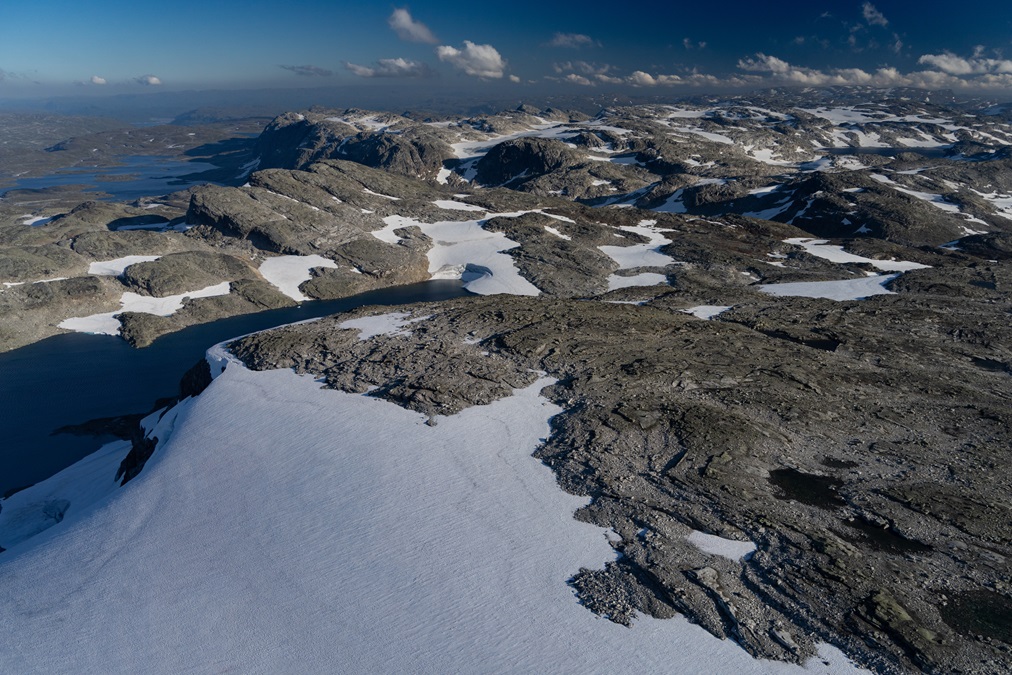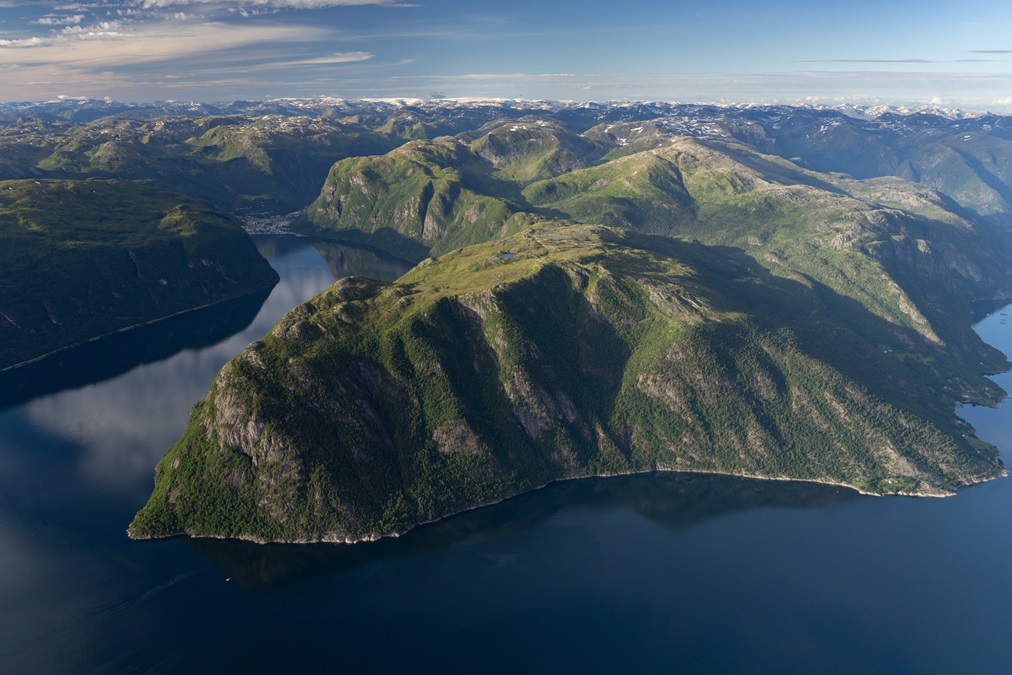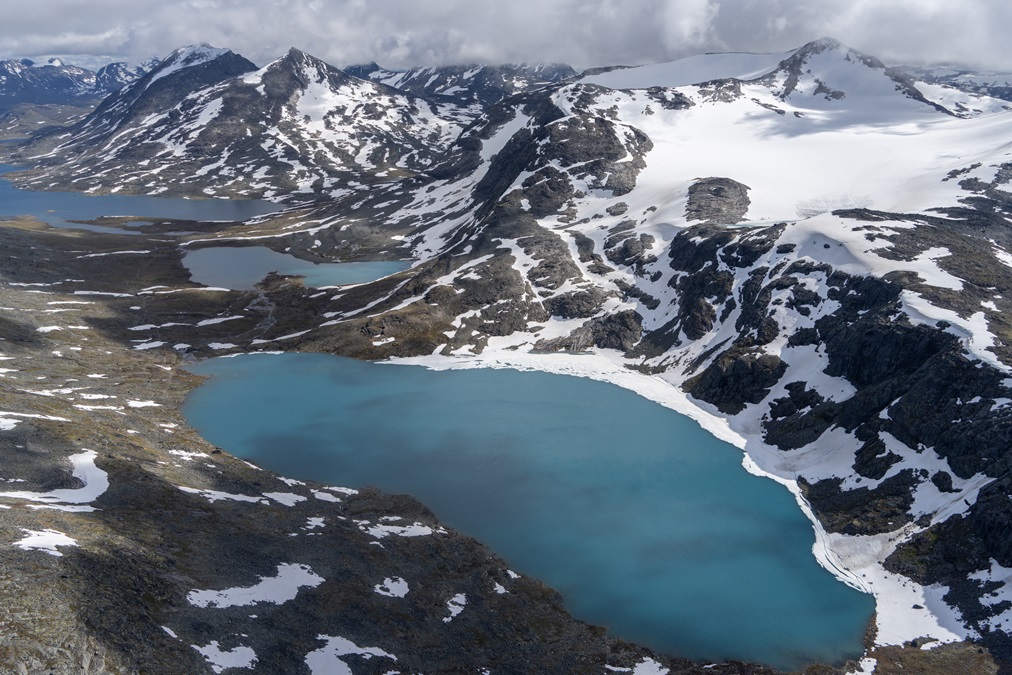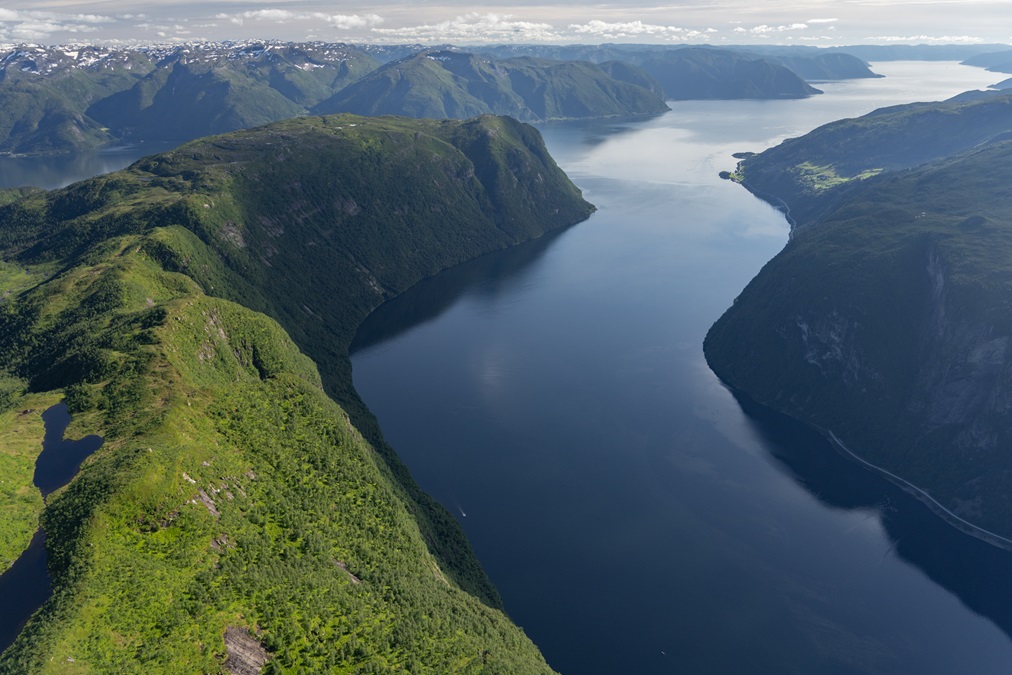Flying the glaciers and high peaks of Southern Norway
An intense summer of flying in a Super Cub
Battling an unusually cold and rainy summer around 61 degrees north latitude, I conquered the glaciers of southern Norway and the highest Scandinavian peaks in just two short months.
The objective in flying the Piper Super Cub to Norway was to photograph the glaciers in Norway and Sweden over the summer. I chose Voss Bømoen Airport (known locally as, simply, "Bømoen") as a base of operation. East of Bergen, it is sandwiched among the largest fjords in Norway, also between the Folgefonna and Jostedalsbreen glacier complexes, the largest in Norway and continental Europe.
The Super Cub’s sellers refused to let me pay them for the hangar space. The airplane had been washed and fueled ahead of my arrival, a sign of hospitality to come for which I was eminently thankful.
I took off to the northwest ahead of worsening weather, for the flight of over two hours to Voss.
My route took me across the Hardangervidda Plateau, a very large area that is entirely above the timberline. With strong winds, high terrain, lowering clouds, and incoming precipitation from the Atlantic, I was admittedly a bit nervous, as the terrain was menacing and Norway was entirely unfamiliar.
After the Hardangervidda, I was able to fly northbound along the Folgefonna, a large glacier unlike what I am accustomed to seeing in the Alps. I landed well into the evening, half an hour before the first rains arrived and temperatures plummeted.
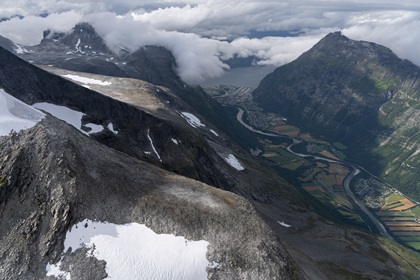
Weather is naturally foremost in one’s mind when situated so far north, just inland from Europe’s rainiest city. Further research showed that the mountains to the west and east of the airport receive annual liquid precipitation measured in meters. None of that was helped by what turned out to be an unusually cold and nasty summer, to the point that Norwegians were complaining about it. We fired up the wood stove on many July afternoons.
I could only stand being on the ground for so many days without flying. On a marginal weather day with strong winds, light precipitation, and a cloud deck at 4,000 feet, I took off on what turned out to be the riskiest flight of my time in Norway.
I flew northeast into the Nærøyfjord and then to the Sognefjord. There were clouds obscuring the top while I flew at 2,500 feet above the water, with vertical cliffs on both sides. While I have seen breathtaking terrain in the Alps, the fjords of Norway were utterly impressive.
So many glaciers, so little fuel
My next flight featured slightly better weather and scenery. It was still windy, though clouds were higher, broken in most places, and there was a gap to the east of the Jostedalsbreen, induced by descending winds. The Jostedalsbreen is the largest glacier in continental Europe, significantly larger than what one can find in the Alps. It is a plateau glacier sitting on top of a ridge at 5,000 to 6,000 feet, with many glaciers descending from it, and fjords on both sides.
It was at this moment, very early in the summer, that I decided that my plan to photograph everything in Norway and Sweden was too ambitious. Everything about the scale was larger than I expected from maps: The fjords are deeper and longer, the spaces grander, the glaciers bigger. I decided that I was going to aim for the glaciers in the southern half of Norway. They stop south of Trondheim and resume a significant distance to the north, where they run almost to the top of Europe. The northern glaciers would have to wait for another summer.

Part of the problem, though by no means the sole contributor, is a surprising lack of fuel in Norway.
From what I understand, a company that had a contract to supply avgas no longer was contracted to do so, which meant that avgas had disappeared from many airports. It certainly was not available at Voss, which meant 34 individual purchases of 98-octane mogas in gas cans over the course of 62 days. I flew south to Stavanger to run some avgas through the Super Cub, as I was still of the belief that it was necessary to prevent valve recession. Roughly around that flight, AOPA published an in-depth article debunking the valve recession theory, so I used as much UL91 and mogas as I could, which resulted in improving metal numbers across the spectrum from my laboratory results.
The flight to Stavanger featured beautiful coastline. Since the sun set after 11 p.m. and Voss allows landings during daylight (latest takeoff 9 p.m.), I flew again on that day, up to the Jostedalsbreen. There was some precipitation here and there, with high overcast ceilings, which had a gap in the clouds at 9:45 p.m., enough to have a rainbow over the glacier. That was a very memorable flight, which showed yet more work that I had to do to cover the glaciers.
Perseverance fills the gaps
After some other flights, each generally lasting two to four hours, it was time to explore Jotunheimen. It is a national park with the highest peaks in all of Scandinavia and in Europe north of the Tatra Mountains. While its highest peak, Galdhøpiggen, is “only” 8,100 feet and the glaciers are lower, it is still a windy place. This proved exceptionally true on an exploratory flight in the range, sandwiched between glaciers and mountains, all under a cloud deck. I must point out that I was also working on a secondary project, photographing the 189 peaks over 2,000 meters in Scandinavia, most of which were located near glaciers. Some of these early flights were merely scoping glacier locations while knocking peaks off of my list.
At that point, the low hanging-fruit of what was available had been picked. I had made exploratory forays to Folgefonna, Hardangerjøkulen, Jostedalsbreen, Ålfotbreen, and Jotunheimen, though I had not comprehensively covered each sector or ventured into farther zones. Many times, I could see one side of a mountain or glacier complex, though not the other, due to cloud cover from stormy weather. I have a personal rule when I photograph the glaciers of a region, that I will get every last one of them, not just hit the high points.
While the gaps in my collection were easy to plan from my computer in the cabin, I could do nothing about the weather. Sometimes, it was a persistent front hanging out to the north, or coastal moisture bunched up against the glaciers to the south. I had to roll with the direction I could go on good flying days.
By the end of July, I reached aviation overload. I located a friendly flying club that operates the airport in Bjorli, a good distance to the north. I could fly three to four hours, land and fuel, and perform a two-to-three-hour flight back, taking thousands of photographs along the way. I did that a few days in a row, until I reached the point that I was glad it rained, so I could sit in the cabin and do office work as a relief.
One bad cylinder
The concept of the 100-hour inspection loomed as this flying binge unfolded. Accustomed to my N-registered Piper PA–11 Cub Special, which does not have a Hobbs meter (or a 100-hour inspection requirement), I was keeping a mental tally of the tach time, until one day I thought to myself: “Is the 100-hour by tach time, or flight hours?” I checked with some other aircraft owners in Europe, and the answer was unanimous: flight time. While I was at 95.1 hours on the tach, I discovered with some horror that I was over 107 hours of flight time. European regulations allow a 10-hour buffer, which does not have to be made up on the next inspection. I had already been in touch with a mechanic from nearby Bergen who, of all things, had shipped a fuselage together with my very own Norwegian-registered aircraft’s fuselage from Alaska for its restoration years ago. A phone call to the sellers created some instant Super Cub camaraderie, so disclosing my flight time predicament was solved with the mechanic promptly driving up after I squeezed the last hours out of the 110-hour allowance, just before another round of rain.
Near the top of the list of worst-case scenarios that I contemplated, second only to being forced to land in a fjord, was a costly repair that required extended down-time, smack in the middle of the frenzy of flying I needed to maintain to achieve the goal. The inspection came close to realizing its nightmare potential.
One of the cylinders unquestionably failed compression. Off it came, revealing a failure of proper break-in, collapsed rings, and the need for a cylinder replacement or overhaul—which explained the roots of a plug fouling problem noted in that cylinder. It was July 31, smack in the middle of the peak of glacier season. With “supply chain issues” being the theme of the summer, including affecting the available stock of Lycoming replacement cylinders, I considered hopping a flight to Switzerland and flying the PA–11 north in my panicked state.
The mechanic called his retired father, who happened to have a freshly overhauled matching cylinder in the barn. “He doesn’t like to part with things, so I am convincing him to bring it until you can replace it.” After some coaxing, both retired parents hopped into the camper van with the cylinder, drove two hours up to Voss, worked until 11 p.m. with the mechanic, and spent the night. I was literally back in the air the next day. We worked out an arrangement where my overhauled cylinder went back into the barn in Bergen, and everyone was happy.
Norwegians are very practical and helpful, for which I am immensely grateful.
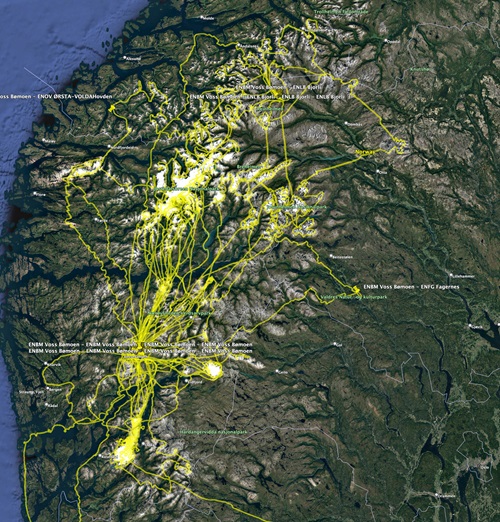
Cramming for the finish
July concluded with 54.5 flying hours. August began with test flights, lots of rain, and high wind, which eventually gave way to conditions closer to what Norwegians expect of summer. Long flight legs starting and ending in Voss resumed, chipping away at smaller and smaller glaciers on the list, along with elements of the large plateau glaciers that previously hid in the clouds.
More ambitious flights were necessary to have hope of finishing the list. I planned one complicated day with a nearly four-hour flight to Ørsta-Volda, where someone from the flying club drove over to sell some fuel. On the way out, I narrowly missed the maritime overcast layer as it roared in, un-forecasted, from the ocean. What would I have done, dipping into the reserve, if it came in before refueling? There are some serious fjords and terrain in that neck of the woods. I almost always flew with full fuel and rarely went below one hour of reserve, as options are too limited in that part of the country.
The final flight in Norway was an eight-hour, single-day binge, where I flew to Bjorli and refueled twice, battling low clouds on the west side of the glaciers, getting the last of the remaining bits on the northern part of the southern half of the country, near 63 degrees north latitude. It was a challenging day with wind, thousands of photographs, and ultimately too much flying.
There was no rest for the wicked, as the next day, I was off to Bergen for the airworthiness certificate renewal. One day of rest, and then another eight hours flying the Super Cub out of Norway on the last day of the month. I stopped for the night in Texel, Netherlands, again, and then dropped it off at Zeeland, Netherlands, for some supplemental type certificate installations.
In the two months of flying in Norway, flight time was 100 hours, 20 minutes.
Norway is the closest country in my experience in Europe to flying in the United States. Landing fees are sent by post, so one can come and go as desired and deal with payment later. Voss and Norwegian state airports have an annual pass, so I paid $250 for all landing fees at Voss for the summer. Norway is spacious with practical-minded people, generally having an atmosphere of deferring on the side of freedom over senseless regulations, at least compared to Central and Southern Europe. My only complaint was the avgas situation, which really made the summer much more difficult, though now I know to research that aspect more thoroughly in the future.
Some friends feared that I would simply stay in Norway and refuse to leave. The idea was tempting, though a number of factors render it unattractive year-round. In any case, there was something raw, inviting, and satisfying about flying above the timberline for hours on end. It was truly an amazingly rugged wilderness in most areas, with few emergency landing options, lots of cold water, and plenty of weather. Some of my best moments were turning on some music for the last hour of a long day of flying, cruising over menacing terrain as the warm evening light after 9 p.m. illuminated the Hardangervidda, often with the next incoming storm looming on the horizon.


